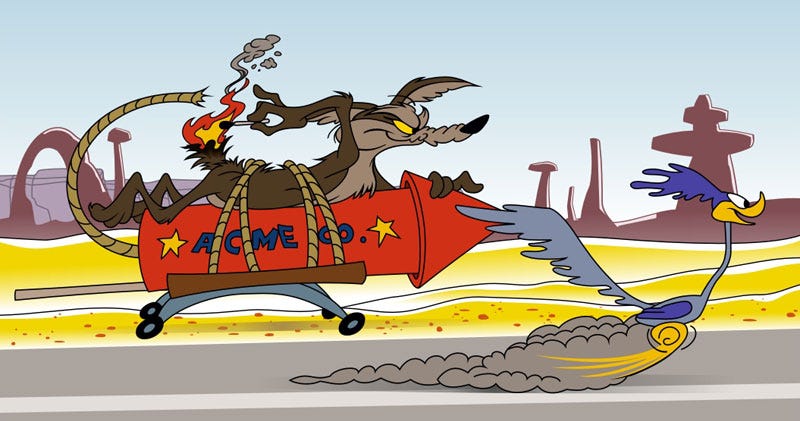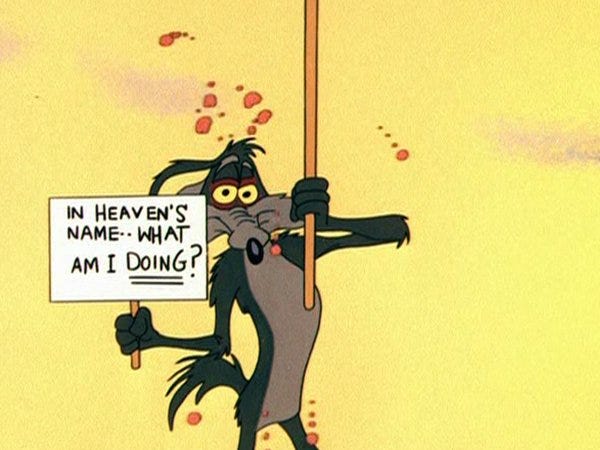We’re constantly thinking thoughts — about 70,000, actually. And most of these thoughts are negative. I’ve read anywhere from 70–80% of our thoughts are negative. There are 86,400 seconds in a day. Now, if we limited the 70,000 thoughts to only waking hours, so let’s say we’re awake for 16 hours, we’d think 1.2 thoughts per second.
It’s just an endless loop of things running through our head like the Road Runner. That’s pretty much your brain. A Road Runner being chased by Wile E. Coyote. And when most of these thoughts are negative, it’s like Wile E. Coyote is constantly running with one of his many traps, waiting for you, the Road Runner, to get caught.

But just like the Road Runner and Wile E. Coyote aren’t real, neither are our thoughts. Scientists aren’t really sure what thoughts are. The current theory is that thoughts are patterns of electricity generated by neurons in our brain.
So, if thoughts aren’t real, then essentially, they only become real when we hold on to a certain thought and act on it. Let’s go back to our cartoon: Chuck Jones, the creator of Wile E. Coyote, originally started this as a thought. It only became real when he drew it and made this into a cartoon. Oddly enough, Wile E. Coyote is based off of Mark Twain’s book, “Roughing It,” where he describes this sickly-looking coyote and says, “is a living, breathing allegory of Want. He is always hungry.” Ironically, I’d argue most of our thoughts are about wanting.
This begs the question: what do we do if we’re constantly thinking (mostly) negative thoughts? What do we do with the Wile E. Coyote in our brain?
You don’t give it power, just like the Road Runner watches Wile E. Coyote hurt himself. Let Wile E. Coyote run out of your mind as fast as he ran in to it. I know, much easier said than done.

I appreciate practical advice, so that’s what I’m going to give. When you have a Wile E. Coyote thought that you can’t easily let run away; when you start fixating on this thought, ask yourself:
Is this 100% true?
Is the thought that randomly popped into your mind — that isn’t necessarily real — actually true? Is it fact or fiction? Can you dissect this thought like an essay or the poor frogs in science class? Analyze the thought. What’s the point in this thought? What’s beyond the thought? Is your brain actually trying to signal something entirely different, but this was just the best way to get your attention? If, after the analysis, you decide that it’s not entirely true, dump it. Let it run off the cliff like Wile E. Coyote.
Another question to ask yourself when you find yourself ruminating on a thought:
Is this contributing to my overall happiness?
If it’s not, drop it like it’s hot. Life is limited, folks. We can’t waste our short lives on thoughts that bring us down. It’s not worth it.
I hate being miserable. I don’t like that I fixate on negative thoughts far too often. We’re a society that seems to value all things negative or fear-based. I recently read the mantra, “If it bleeds, it leads,” which is a fear-based logic the media uses to A. Get people’s attention and B. to persuade you into thinking a certain thing.
From this point on, you have two options: give shitty thoughts the Finger and move on with your life, or fall into this fear-based, negative thinking trap. Ruminate. Make yourself miserable. Be the Wile E. Coyote and hurt yourself instead. We’re unfortunate enough to have 70,000 thoughts running through our brains, but we’re fortunate enough to have the choice. Choose Wisely.

Thanks to my patrons who make my writing possible. You can become part of our club here:
Become a Patron!